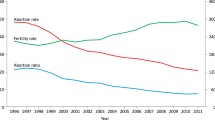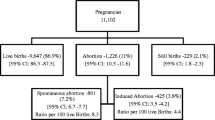Abstract
Study objective: To describe the use of induced abortion (IA) in Asturias after its legalisation as well as the socio- demographic characteristics of women applying for abortion. Design and setting: Descriptive study, population-based, using data collected by the regional abortion surveillance system for the period 1988–1994. Main results: The number of IA and the abortion rate (AR) (10 per 1000 women aged 15–49) have been stable in Asturias during the study period. The highest ARs were found for women in the age group 20–34, for divorced/separated, for women with a higher educational level and for women with only one child. The proportion of pregnancies which ended in abortion was one in four; for teenagers and women over 34 years it was one in two. This proportion was also higher for women not married, students and women with two or more children. Ninety-eight percent of all abortions took place in private clinics, the woman's physical/mental health being the medical indication for these abortions. Abortion was most often performed within eight weeks of gestation (65%). Late abortion ocurred more frequently among teenagers and women of low educational level. Eighteen percent of women had repeated abortions. A high proportion (61%) of women applying for abortion had not used the Family Planning (FP) services in the previous two years; adolescents and women of low educational level had the lowest frequencies of FP use. Conclusions: Compared with that of other European countries, the AR in Asturias was intermediate. The results regarding adolescents show the need for evaluation and promotion of sex education and contraceptive programmes. The lower and later use of abortion by women of low educational level shows inequalities that call for specific action.
Similar content being viewed by others
References
Tietze C. Informe Mundial sobre el Aborto. Ed. Ministerio de Cultura, Instituto de la Mujer. Madrid, 1987.
SADEI. Movimiento Natural de la Población Asturiana 1988–1994. Ed. Servicio de publicaciones del Principado de Asturias.
SADEI. Características de la Población de Asturias 1986. Bilbao, 1988.
SADEI: Censo de Población de Asturias 1991. Características de la Población. Asturias, 1993.
Figá-Talamanca I, Grandolfo M, Spinelli A. Epidemiology of legal abortion in Italy. Int J Epidemiol 1986; 15: 343–351.
Spinelli A, Grandolfo M, Pediconi M, et al. Epidemiologia dell'interruzione volontaria di gravidanza in Italia. Epidemiologia e Prevenzione 1991; n.48–49: 198–200.
Ministerio de Sanidad y Consumo. Interrupción voluntaria del embarazo 1994. Madrid, 1995.
Rodriguez C, Sendra JM, Regidor E, et al. Propuesta de un método para estimar la subnotificación del aborto inducido practicado en España. Gac Sanit 1994; 8: 63–70.
Södeberg H, Andersson C, Janzon L, et al. Socio-demographic characteristics of women requesting induced abortion. Acta Obstet Gynecol Scand 1993; 72: 365–368.
CDC. Abortion Surveillance: Preliminary Data-United States, 1990. MMWR 1992; 41: 936–938.
Mosquera C and Uría M. El aborto legal en Asturias y la evolución de la fecundidad. Submitted to Gac Sanit.
Forrest JD, Singh S. The sexual and reproductive behaviour of American women, 1982–1988. Fam Plann Perspect 1990; 22: 76–89.
CDC. Unintended Childbearing: Pregnancy Risk Assessment Monitoring System-Oklahoma. MMWR 1992; 41: 933–936.
Ventura S, Taffel S, Mosher W. Estimates of pregnancies and pregancy rates for the United States, 1976–85. AJPH 1988; 78,n.5: 506–511.
Rantkallo P, Myhrman A. Changes in fertility and the acceptability of pregnancies in Northern Finland during the last 20 years. Int J Epidemiol 1990; 19,n.1: 109–114.
Consejería de Educación: Informe Juventud, Asturias 1994. Ed. Servicio de Publicaciones del Principado de Asturias. Asturias, 1995.
Koonin LM, Kochanek KD, Smith JC, et al. Abortion surveillance, United States, 1988. MMWR 1989; 40,n.ss-1: 15–42.
Hamark B, Uddenberg N, Forssman L. The influence of social class on parity and psychological reactions in women coming for induced abortion. Acta Obstet Gynecol Scand 1995; 74: 302–306.
Smith T. Influence of socioeconomic factors on attaining targets for reducing teenage pregnancies. Br Med J 1993; 306: 1232–1235.
Garlick R, Ineichen B, Hudson F. The UPA Score and Teenage Pregnancy. Public Health 1993; 107: 135–139.
Cayley J. Emergency contraception. Time to loosen medical controls over its availability. Br Med J 1995; 311: 762–763.
Pearson VAH, Owen MR, Phillips DR, et al. Pregnant teenagers' knowledge and use of emergency contraception. Br Med J 1995; 310: 1644.
Author information
Authors and Affiliations
Rights and permissions
About this article
Cite this article
Uria, M., Mosquera, C. Legal abortion in Asturias (Spain) after the 1985 law: Sociodemographic characteristics of women applying for abortion. Eur J Epidemiol 15, 59–64 (1999). https://doi.org/10.1023/A:1007541904470
Issue Date:
DOI: https://doi.org/10.1023/A:1007541904470




